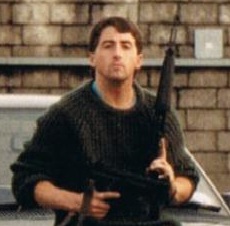Ian Hurst
Ian Hurst is a former British Army soldier. He served in the Intelligence Corps and in the Force Research Unit. Under the pseudonym Martin Ingram he publicised claims that Freddie Scappaticci was an IRA informer codenamed Stakeknife.[1]
Army
Hurst joined the army as a private soldier in 1980. He completed his Intelligence Corps training the following year and was promoted to lance corporal. He was posted to Northern Ireland in late 1981 and worked in the special collation team which was transferring intelligence material on to the then newly introduced computer database.[2]
After three months he moved to 121 Intelligence Section at Head Quarters Northern Ireland (HQNI), where how worked as a collator. In autumn 1983 he was posted to the Force Research Unit. he was employed by the FRU for just under a year as a collator, during which time he was promoted to corporal. From 1984 to 1987, he was employed in Great Britain, including a six month tour abroad. He was promoted to sergeant in 1986. In late 1987, he was posted to the FRU in Northern Ireland as an agent handler. he served in this role for just under three years. His final posting was as a collator in the Defence Intelligence Staff in the Ministry of Defence. he left the Army in 1991.[2]
"Martin Ingram"
According to Hurst, he decided to write a book in 1997, "to highlight aspects of my service which had a genuine public interest.[3]
Following a series of articles in the The Times in 1999, Hurst was arrested by Special Branch police officers in connection with alleged breaches of the Official Secrets Act. He was not charged but was subject to an injunction.[3]
Hurst moved to France in 2004.[3]
Computer hacking
Hurst was allegedly hacked by private detective Philip Campbell Smith on behalf of the News of the World in the summer of 2006.[3] [4]
Hurst later stated:
- I now cannot recall whether I opened an email from a bogus address in 2006. However, I can say that ~ would have been much more likely to have opened an email that had come from a trusted contact rather than an unfamiliar or unknown name. I do know that an email was sent to me by a trusted media contact within Times Newspapers Ltd around the time the Trojan became active and was collecting information from my computer. I have recently seen evidence that this individual was in email contact with X regarding my activities during these months, something which had previously been denied.[3]
The 'X' referred to was Philip Campbell Smith.[4]
The police first became aware that Hurst's computer had been compromised during an arrest in 2007.[3]
The police allegedly obtained further information about the hacking of Hurst's computer following the arrest of Philip Campbell Smith in 2009.[3] [4]
In late December 2010, Hurst was approached by Stephen Scott of Panorama with evidence that his computer had been hacked.[3]
Hurst subsequently confronted the alleged hacker in a meeting that was secretly filmed by Panorama. he told the Leveson Inquiry:
- During the course of our meeting, X stated that he had placed a computer Trojan on my hard drive (by sending me an email from a bogus address which t then opened) and had, over a three month period, obtained all email traffic which was sent and received by me.[3]
Hurst was not informed of the hacking by police until October 2011.[3]
External Resources
- "Martin Ingram" Witness statement, Bloody Sunday Inquiry.
- Oral Testimony, Day 329, Bloody Sunday Inquiry, 12 May 2003.
- Evidence: Ian Hurst, Leveson Inquiry, 28 November 2011.
- ReadNotify tracking journalists and their sources, or being used for disinformation?, Spy Blog, 29 October 2006.
- Barry McCaffrey, PSNI gets limited access to army intelligence says former soldier, The Detail, 14 March 2011.
- Mark Hennessy, Irish editor accused of spying on ex-agent, Irish Times, 15 March 2011.
- Roy Greenslade, An overlooked Panorama scoop as a British soldier breaks cover, Greenslade Blog, guardian.co.uk, 16 March 2011.
- Paul Larkin, The Guardian continues its “battle” with Sinn Féin, fadooda.com, 18 September 2011.
- James Cusick, Intercepted intelligence could not have been published, says witness, Independent, 29 November 2011.
Notes
- ↑ Roy Greenslade, An overlooked Panorama scoop as a British soldier breaks cover, Greenslade Blog, guardian.co.uk, 16 March 2011.
- ↑ 2.0 2.1 "Martin Ingram" Witness statement, Bloody Sunday Inquiry.
- ↑ 3.0 3.1 3.2 3.3 3.4 3.5 3.6 3.7 3.8 3.9 [Witness Statement of Ian Hurst], Leveson Inquiry, 9 November 2011.
- ↑ 4.0 4.1 4.2 Vikram Dodd and Nick Davies, Man convicted in conspiracy case also accused of hacking computer for NoW, The Guardian, 20 February 2012.
